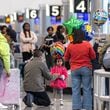When Hurricane Irma struck last September, 16 of Carnival’s cruise ships were sailing the Caribbean. The Carnival team scrambled to reroute ships, rebook passengers embarking or debarking, and set up new port calls out of harm’s way.
Next time a storm threatens, the task will be easier, thanks to a new, state-of-the-art fleet operations center that tracks weather, ship location, engine performance, fuel supplies, safety systems and dozens of other data points from all 26 ships in the Carnival fleet, plus outside sources such as the Coast Guard and the National Atmospheric and Oceanic Administration.
Previously, land-based monitoring was scattered across multiple locations in the cruise company’s Doral headquarters and relied on individual ship and system reports. The new operations center, unveiled recently, displays exact locations and other details on a 74-foot-long video wall flanked by 150 employees and glass-walled conference rooms that allow incident teams to meet in quiet.
A circular matrix display alerts a 24/7 watch team of cascading effects. For instance, if a ship experiences a delay in departure, the display posts an alert to check on provisioning, guest travel plans, fuel supply and other port calls that might be affected. “A person might not remember all the things you need to check. This quickly gives an update,” said Richard Miller, vice president of nautical and safety operations.
If a ship deviates from its planned route, as it did in the run-up to the 2012 Costa Concordia sinking, the 24/7 team would be alerted. If safety could be affected, an alarm is triggered, Miller said.
The new Doral center is part of a three-site monitoring system for Carnival’s corporate fleet of more than 100 ships from brands Holland America, Seabourn, Princess, Cunard, P&O, Costa and AIDA. The three centers — in Doral; Hamburg, Germany; and Seattle — routinely scan for different ships but can act as backups for the entire fleet.
About the Author





